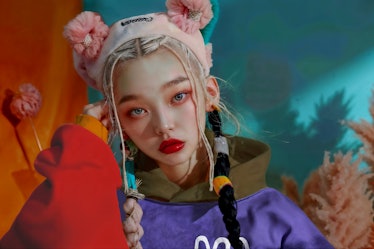Three years ago, the writer and entrepreneur Colby Mugrabi overheard her husband talking on the phone and felt her ears perk up. It was the day after a digital artwork by Beeple had sold at Christie’s for a staggering $69.3 million, knocking the traditionally luddite art world off its axis. Mugrabi’s husband, the art dealer and mega-collector Alberto Mugrabi, was fielding an onslaught of calls from clients demanding a crash course in NFTs (non-fungible tokens) and the metaverse. Intrigued, Colby decided to research the subject herself. It didn’t take long before she became a convert. “I realized instantaneously, this is the future of where my brand should live,” she says.
One massive crypto crash, many months of technical development, and $6.4 million in seed funding later, Mugrabi is preparing to debut the first collection from her new company, Mmerch, on April 16. Describing itself as a purveyor of “non-fungible fashion,” Mmerch offers one-of-one designs developed by a bespoke algorithm along with corresponding NFTs. The company aims to fuse generative AI design, which has infiltrated the fashion industry over the past year, with the community-driven culture of NFTs to build a brand that appeals to fashion lovers and Web3 devotees alike. Notably, Beeple (real name: Mike Winkelmann), the artist who started Mugrabi on the path to NFT entrepreneurship, is on board as an advisor.
Mmerch’s first drop is a collection of 960 unique hoodies that are inspired by NFT collections like the Bored Ape Yacht Club and CryptoPunks, whose algorithmically generated features vary in rarity. The hoodies are made from six components: a hood, a body, a front pocket, two sleeves, and bands on the bottom and around the wrists. Each can be produced in 20 different colors, 10 different patterns (like floral, gingham, and camouflage), and two materials (French terry and cashmere).
While every item has a unique combination of elements, some features are rarer than others. (Ironically, Mugrabi notes that a monochrome hoodie—the most common option in the real world—is especially rare in the Mmerch universe.) The first drop will cost .15 ETH, equivalent to $525 at press time. Unlike some more superficial generative fashion projects, which involve slapping a generative artwork on a t-shirt, “we’re generative down to manufacturing,” Mugrabi says. “It’s the algorithm that assembles the garment.”
Yet the process required a lot more than typing a few lines into ChatGPT. Mugrabi interviewed around 20 factories before finding two that were willing to take on such a novel job. (One, in Los Angeles, will produce the terry hoodies; another, in Italy, will make the cashmere ones.) Rather than cut the materials for each garment, the factories cut material for each attribute (like the hood or the body) before assembling them according to the algorithm’s outputs. “Everyone who knew anything about manufacturing said that it couldn’t be done,” Mugrabi says.
Although the hoodies’ aesthetic is considerably more tech bro than haute couture, a recent launch party convened well-connected figures in the fashion and art worlds, including Diane von Furstenberg, Dasha Zhukova, Marc Jacobs, Nicky Hilton, and Sandy Heller. A few hoodies were installed throughout the space between glass panels with the reverence of an art installation.
The project’s final form reflects a few pivots. Initially, Mugrabi had resolved to become a landlord for fashion brands in the metaverse. “I even hired architects to build out a piece of my land,” she says. But the project struggled to gain traction and she ended up shifting her focus to generative fashion and wearable items for the metaverse. Then came the crypto bear market, which saw NFT trading volume plummet 97 percent from its 2021 high. That’s when she decided to double down on the real-world, physical component of Mmerch: the hoodie.
Mugrabi feels the project’s success hinges on its ability to offer benefits that keep people engaged and serve as a thread connecting the virtual and physical worlds. Only after collectors claim the virtual hoodie’s physical twin will the NFT—one of 48 characters drawn by the comic book artist Gilbert Hernandez—become fully colored in. (The objective is to avoid a scenario in which a collector buys an NFT on the secondary market thinking they will get the physical component as well, only to find out it has already been redeemed.)
An NFC chip embedded in the IRL hoodie is linked to a digital wallet, which allows the wearer to collect rewards and enter special events. (Just don’t iron the hoodie—you might damage the chip.) Mugrabi imagines a future in which someone might wear their Mmerch gear to MoMA, scan their chip, gain free entry to the museum, and have a themed token sent to their virtual wallet. “I approach our product as programmable pieces of hardware but instead of a computer, it’s a garment,” she says.
So where does Mmerch go from here? In the short term, Mugrabi plans to have quarterly drops featuring artist-designed NFTs and new physical items. (The second drop is hoodies, but she’s also looking into socks, backpacks, and hats.) From there, the company’s consumer application of blockchain technology could be white-labeled for other brands. Mugrabi also hopes to develop one-of-one wearables for the metaverse. Virtual real estate values may have tumbled since she first dreamt of becoming a Web3 Warren Buffett, but she remains optimistic about the potential of the virtual universe. “That was early,” she says, “and now it’s still early.”

